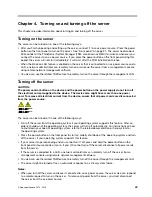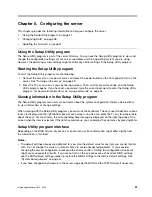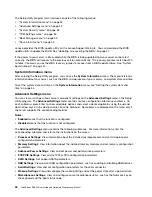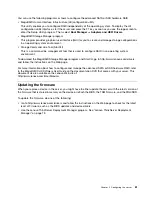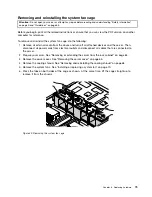
•
RAID 10
: a combination of RAID 0 and RAID 1
RAID 10 consists of striped data across mirrored spans. A RAID 10 drive group is a spanned drive
group that creates a striped set from a series of mirrored drives. RAID 10 allows a maximum of eight
spans. You must use an even number of drives in each RAID virtual drive in the span. The RAID 1
virtual drives must have the same stripe size. RAID 10 provides high data throughput and complete data
redundancy but uses a larger number of spans.
RAID 10 requires a minimum number of four hard disk drives and also requires an even number of drives,
for example, six hard disk drives or eight hard disk drives.
•
RAID 50
: a combination of RAID 0 and RAID 5
RAID 50 uses distributed parity and disk striping. A RAID 50 drive group is a spanned drive group in
which data is striped across multiple RAID 5 drive groups. RAID 50 works best with data that requires
high reliability, high request rates, high data transfers, and medium-to-large capacity.
Note:
Having virtual drives of different RAID levels, such as RAID 0 and RAID 5, in the same drive group is
not allowed. For example, if an existing RAID 5 virtual drive is created out of partial space in an array, the
next virtual drive in the array has to be RAID 5 only.
RAID 50 requires a minimum number of six hard disk drives.
•
RAID 60
: a combination of RAID 0 and RAID 6
RAID 60 uses distributed parity, with two independent parity blocks per stripe in each RAID set, and disk
striping. A RAID 60 virtual drive can survive the loss of two drives in each of the RAID 6 sets without
losing data. RAID 60 works best with data that requires high reliability, high request rates, high data
transfers, and medium-to-large capacity.
RAID 60 requires a minimum number of six hard disk drives.
For detailed information about RAID, refer to “Introduction to RAID” in the
MegaRAID SAS Software User
Guide
on the documentation DVD that comes with your server.
Configuring RAID using the Lenovo ThinkServer Deployment Manager
program
Deployment Manager simplifies the process of configuring supported RAID. The help system for the program
can be accessed directly from the program interface.
Deployment Manager has the following features for RAID configuration:
• For use with all supported RAID controllers
• Automatically detects hardware and lists all supported RAID configurations
• Configures one or more disk arrays per controller depending on the number of drives attached to the
controller and the RAID level selected
• Supports hot-spare drives
• Creates a RAID response file that can be used to configure RAID controllers on similarly configured
Lenovo servers
See “Lenovo ThinkServer Deployment Manager” on page 13 and view the help system from the main
interface of the program.
Configuring the advanced SATA or SAS hardware RAID
Your server comes with an AnyRAID adapter to provide advanced SATA or SAS hardware RAID functions.
Note:
Depending on the operating system, the total drive capacity of the primary RAID might be limited to
2 TB.
60
ThinkServer RD450 User Guide and Hardware Maintenance Manual
Summary of Contents for ThinkServer RD450
Page 14: ...xii ThinkServer RD450 User Guide and Hardware Maintenance Manual ...
Page 18: ...4 ThinkServer RD450 User Guide and Hardware Maintenance Manual ...
Page 20: ...6 ThinkServer RD450 User Guide and Hardware Maintenance Manual ...
Page 62: ...48 ThinkServer RD450 User Guide and Hardware Maintenance Manual ...
Page 76: ...62 ThinkServer RD450 User Guide and Hardware Maintenance Manual ...
Page 196: ...182 ThinkServer RD450 User Guide and Hardware Maintenance Manual ...
Page 206: ...192 ThinkServer RD450 User Guide and Hardware Maintenance Manual ...
Page 218: ...204 ThinkServer RD450 User Guide and Hardware Maintenance Manual ...
Page 224: ...210 ThinkServer RD450 User Guide and Hardware Maintenance Manual ...
Page 225: ......
Page 226: ......




